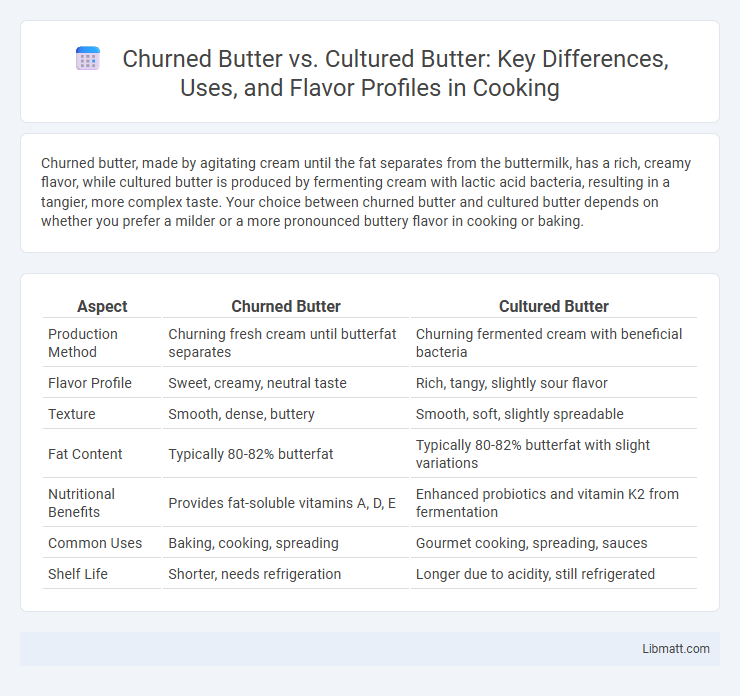Churned butter, made by agitating cream until the fat separates from the buttermilk, has a rich, creamy flavor, while cultured butter is produced by fermenting cream with lactic acid bacteria, resulting in a tangier, more complex taste. Your choice between churned butter and cultured butter depends on whether you prefer a milder or a more pronounced buttery flavor in cooking or baking.
Table of Comparison
| Aspect | Churned Butter | Cultured Butter |
|---|---|---|
| Production Method | Churning fresh cream until butterfat separates | Churning fermented cream with beneficial bacteria |
| Flavor Profile | Sweet, creamy, neutral taste | Rich, tangy, slightly sour flavor |
| Texture | Smooth, dense, buttery | Smooth, soft, slightly spreadable |
| Fat Content | Typically 80-82% butterfat | Typically 80-82% butterfat with slight variations |
| Nutritional Benefits | Provides fat-soluble vitamins A, D, E | Enhanced probiotics and vitamin K2 from fermentation |
| Common Uses | Baking, cooking, spreading | Gourmet cooking, spreading, sauces |
| Shelf Life | Shorter, needs refrigeration | Longer due to acidity, still refrigerated |
What is Churned Butter?
Churned butter is made by vigorously agitating fresh cream until the fat separates from the buttermilk, resulting in a dense, creamy product with a rich, natural flavor. Unlike cultured butter, which is made by fermenting cream before churning to develop tangy notes, churned butter lacks the distinct sourness and has a smoother, sweeter taste. Understanding the difference can help you choose the right butter for cooking or baking based on flavor preference and recipe requirements.
What is Cultured Butter?
Cultured butter is made by fermenting cream with lactic acid bacteria before churning, which enhances its flavor profile with a rich, tangy taste. Unlike regular churned butter, cultured butter offers a creamier texture and deeper aroma due to the fermentation process. Your recipes can benefit from the unique, complex flavor that cultured butter imparts, making it a preferred choice in gourmet cooking and baking.
Differences in Production Methods
Churned butter is made by agitating cream until the fat separates from the buttermilk, resulting in a dense, creamy texture. Cultured butter, on the other hand, undergoes a fermentation process where lactic acid bacteria are added to cream before churning, enhancing its flavor with a tangy, complex profile. Understanding these differences in production methods helps you choose butter that suits your culinary needs and taste preferences.
Taste and Flavor Profile Comparison
Churned butter offers a rich, creamy taste with a sweet, fresh dairy flavor, reflecting the natural milkfat content. Cultured butter features a tangy, slightly sour note due to bacterial fermentation, enhancing complexity and depth in flavor. The fermentation process in cultured butter creates a more pronounced buttery aroma and a nuanced, savory profile compared to the straightforward creaminess of churned butter.
Texture and Appearance
Churned butter features a dense, creamy texture with a pale, uniform yellow color, indicating its straightforward churning process from fresh cream. Cultured butter exhibits a softer, more spreadable consistency and a slightly tangy flavor, often accompanied by a deeper yellow hue due to the fermentation of cream with lactic acid bacteria. The fermentation process in cultured butter enhances its richness and creates a smoother, more luxurious mouthfeel compared to the firmer texture of churned butter.
Nutritional Value: Churned vs Cultured
Churned butter retains a higher amount of natural milk fats and fat-soluble vitamins like A, D, E, and K compared to cultured butter, which undergoes fermentation that can alter its nutritional profile. Cultured butter typically contains beneficial probiotics due to the fermentation process, promoting gut health and improved digestion. Your choice between churned and cultured butter can influence nutrient intake depending on whether you prioritize vitamin richness or probiotic benefits.
Culinary Uses and Applications
Churned butter has a creamy texture and rich flavor ideal for baking, cooking, and spreading, making it suitable for pastries, sauces, and sautes. Cultured butter, known for its tangy taste and higher acidity, enhances dishes like gourmet spreads, salad dressings, and finishing touches on steaks and seafood. Your choice between churned and cultured butter can elevate specific culinary applications by complementing the flavor profiles of different recipes.
Shelf Life and Storage Differences
Churned butter typically has a longer shelf life due to its lower moisture content and fewer live cultures compared to cultured butter, which contains beneficial bacteria that can shorten its freshness period. Cultured butter requires refrigeration to maintain its tangy flavor and prevent spoilage, whereas churned butter, especially salted varieties, can be stored at cool room temperatures for short periods without significant quality loss. To ensure your butter stays fresh, always store it properly in airtight containers and follow the recommended refrigeration guidelines based on the type you choose.
Health Benefits of Each Butter Type
Churned butter contains fewer probiotics but offers a rich source of fat-soluble vitamins A, D, E, and K that support overall health and immune function. Cultured butter contains beneficial lactic acid bacteria, promoting gut health and aiding digestion through natural probiotics. Both types provide essential fatty acids that contribute to heart health and energy metabolism.
Which Butter Should You Choose?
Churned butter offers a classic, creamy texture with a neutral flavor, making it ideal for everyday cooking and baking, while cultured butter provides a tangy, rich taste due to fermentation, enhancing dishes that benefit from added depth and complexity. For those prioritizing flavor, cultured butter is preferred in spreads and gourmet recipes, whereas churned butter suits recipes requiring a straightforward buttery essence. Choosing between them depends on desired taste profiles and culinary applications.
Churned Butter vs Cultured Butter Infographic

 libmatt.com
libmatt.com